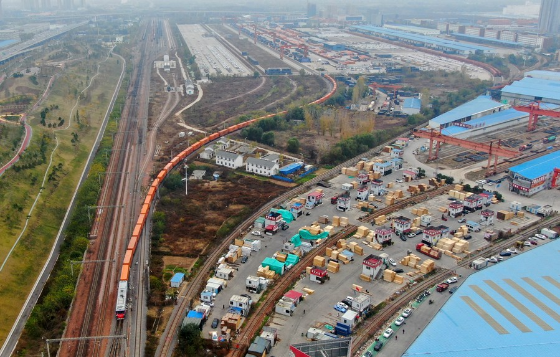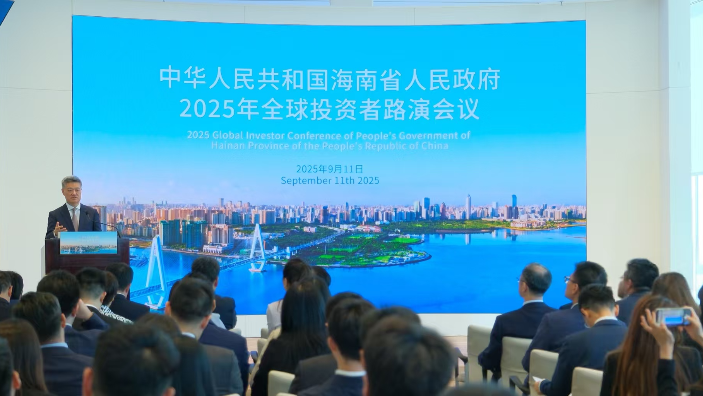By continuing to browser our site and use the services you agree to our use of cookies, Privacy Policy and Terms of Use. You can change your cookie settings through your browser.

Aerial photo shows a China-Europe freight train bound for Finland's Helsinki departing from the Putian Railway Station in Zhengzhou, Central China's Henan province, Nov 20, 2020. [Photo/Xinhua]
Premier Li Keqiang's Government Work Report has shown China's confidence in achieving sustainable development and further opening-up in the coming years and decades, according to international experts.
In the report delivered on Friday, at the opening of the fourth session of the 13th National People's Congress in Beijing, Li reviewed government work in 2020 and the 13th Five-Year Plan (2016-20). He also presented blueprints and main goals for 2021, the 14th Five-Year Plan (2021-25) and into 2035.
Yutaka Matsuno, a former senior researcher at Nomura Research Institute, said that people in Japan had paid close attention to the report, especially its economic and social developments targets.
"From the perspective of macro policy, I think the targets proposed in the Government Work Report are reasonable and feasible," he said.
Yuzo Tanaka, a professor of economics at Ryukoku University in Kyoto, Japan, said that the GDP target reflected China's confidence following its successful containment of COVID-19.
"Although there are many uncertainties stemming from the coronavirus pandemic, the Chinese economy should very easily coast to the target growth rate," Tanaka said, adding that the 6 percent target is rather modest while 7 or 8 percent is more plausible.
Tursunali Kuziyev, a professor at Journalism and Mass Communications University of Uzbekistan, agreed, adding that the "China engine" will continue to boost the world economy.
Alicia Garcia-Herrero, chief economist for Asia-Pacific at French financial services firm Natixis, wrote on Friday in an analysis of the work report: "While the government report sets particular targets for 2021, our reading tends to be more structural, which should be analyzed together with the 14th Five-Year Plan, which is scheduled to help China embark on a more sustainable trajectory over the long term.
"The government report reaffirms China's stance to embrace global trade and investment through opening up the economy to attract foreign capital and promote competition."
Garcia-Herrero, also a senior fellow at Brussels-based think tank Bruegel, said that the Chinese government is showing its interest in expanding regional agreements with key trading partners, such as accelerating free trade talks with Japan and Republic of Korea and joining the Comprehensive and Progressive Agreement for Trans-Pacific Partnership.
Trade partnerships
Christopher Bovis, a professor of international business law at the University of Hull in the United Kingdom, said the Chinese government has highlighted the foundations of international cooperation by enhancing global trade partnerships, which are based on free trade and market access.
"The 14th Five-Year Plan emphasizes economic growth through the availability of technology, skills, an educated workforce, a positive attitude to risk-takers, finance and the other conditions which form a truly competitive and innovative business environment," he said.
"China is building upon structural reforms and continuous opening-up of its economy whilst playing a leading role in climate change and sustainable development," he added.
Hege Fjellheim, head of carbon research at Refinitiv, a global provider of financial market data and infrastructure, said that the 14th Five-Year Plan highlights carbon neutrality and maps out initial steps toward China's long-term climate goal.
"It shows China intends to stay firm in meeting its pledge under the Paris Agreement (on climate change). It is also very encouraging that the plan vowed to accelerate the development of the newly launched national carbon market," said Fjellheim, whose carbon research team works in Norway and China.
She said that the 18 percent carbon intensity reduction target will leave some room for China's emissions to grow, implying that China will need to do more heavy lifting in the 15th Five-Year Plan (2026-30) period to achieve peak carbon before 2030.
Alexander Lomanov, deputy director of the Institute of World Economy and International Relations at the Russian Academy of Sciences, stressed that China continues to push high-quality development to achieve the main goals of the 14th Five-Year Plan and the vision for China in 2035.
"This is an important signal for countries cooperating with China that China is a reliable partner and a hopeful partner," he said.
Leela Mani Paudyal, a former Nepalese ambassador to China, said that the government report underlines China's policy of deepening bilateral and regional economic cooperation, which will benefit neighboring countries like Nepal.
He said the reasons for China's continuous growth can be exemplified by the relatively effective control of the pandemic, positive economic growth and achieving poverty alleviation goals during the pandemic.
Ren Qi in Moscow, Wang Mingjie in London and Yang Han in Hong Kong contributed to this story.
FTP Expert Talks | Xiaodong Lee, Vice President of the Internet Society of China and Founder of the Fuxi Institution: Hainan is the "Nebula" of New Digital Youth
09:47, 12-September-2025Hainan Issues Offshore RMB Bonds in HK for 4th Consecutive Year
09:46, 12-September-20252025 Hainan FTP International Students Content Creation Project
02:28, 12-September-2025What Makes "Hainan Travel" So Appealing?
09:38, 11-September-2025100 Days to Go: What's Next for Hainan-Hong Kong Cooperation?
09:38, 11-September-2025Expert Talks Ep. 4: The Future of the FTP's Digital Economy
09:35, 11-September-2025By continuing to browser our site and use the services you agree to our use of cookies, Privacy Policy and Terms of Use. You can change your cookie settings through your browser.





